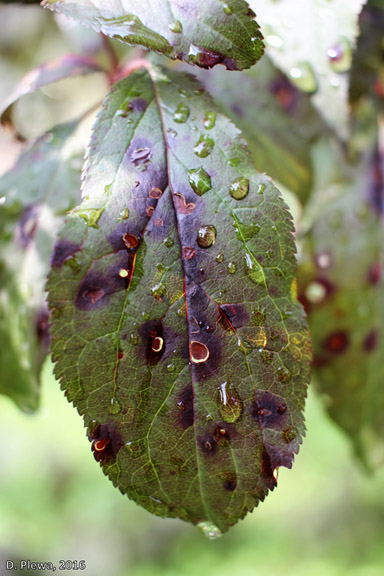Issue 12, July 26, 2016
Cherry Leaf Spot on Cherry and Plum Trees
We've had a larger-than-normal number of stone fruit samples with cherry leaf spot. This disease is caused by the fungal pathogen Blumeriella jaapii. Disease development is favored by humid weather, which is one reason we've seen more of it this year than usual.
The fungus can infect production and ornamental cherry and plum trees. Symptoms start to develop in early summer as small, round, purple spots on the upper surface of older leaves. Eventually, the spots turn reddish brown, and they may coalesce to form larger, irregular dead areas on the leaf. The center of the spots may dry and fall out of the leaf, causing a "shot hole" appearance. Leaf tissue near the older spots turns yellow, and the leaves start to die and fall from the tree by mid-summer.

Cherry leaf spot on ornamental plum. Note the dark purple spots, and the round, necrotic tissue that is about to fall out of the leaf, leading to a "shot hole" appearance. Photo credit: Diane Plewa / University of Illinois Plant Clinic.
Because the fungus overwinters on infected leaf material, removing the fallen leaves and burning or disposing of them is important to reduce the amount of inoculum in the environment. Fungicides can be applied to highly susceptible trees, or trees that were badly affected in previous years. Fungicides containing chlorothalonil, chlorothalonil + thiopanate-methyl, copper + mancozeb, mancozeb, myclobutanil, propiconazole, and pyraclostrobin + boscalid are labeled for use against this disease. Applications should begin in spring at petal fall, with two applications with a 2-week interval between. If symptoms continue to develop, or if the spring application was missed, later applications in summer may be warranted especially if the summer has been particularly wet or humid. Make sure to check that the fungicide you choose is labeled for use on production (edible) cherry or plum trees before applying anything to a tree you plan to harvest.
Because this disease and the resulting defoliation can cause severe stress to the tree, we recommend increasing the vitality of infected trees by mulching the base of the tree, applying a fertilizer in late fall or early spring, watering at the base during periods of dryness lasting for more than 2 weeks in summer, and pruning out dead wood during dry weather. (Diane Plewa)
Author:
Diane Plewa